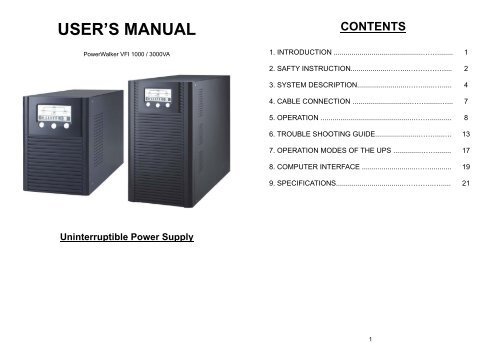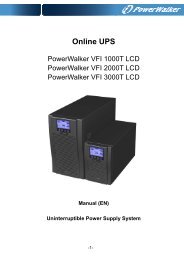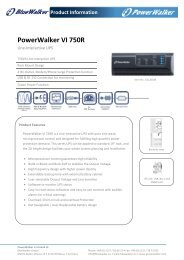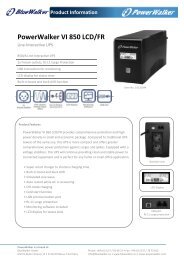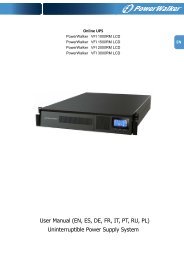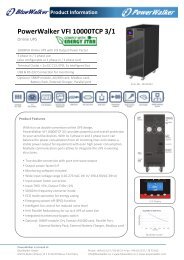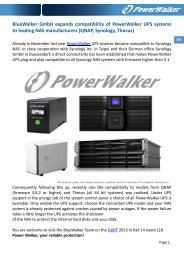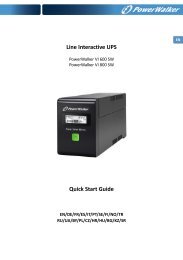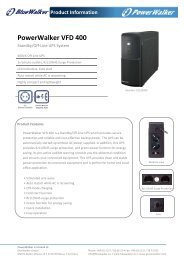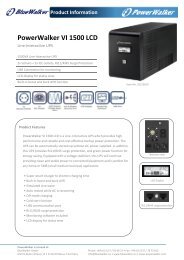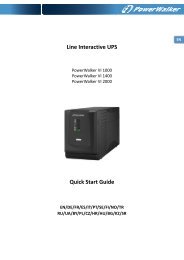You also want an ePaper? Increase the reach of your titles
YUMPU automatically turns print PDFs into web optimized ePapers that Google loves.
USER’S <strong>MANUAL</strong><strong>PowerWalker</strong> VFI 1000 / 3000VACONTENTS1. INTRODUCTION .............................................……........ 12. SAFTY INSTRUCTION...................……...…………….... 23. SYSTEM DESCRIPTION..........................……......…..... 44. CABLE CONNECTION ..............................…….......…... 75. OPERATION ................................................……........... 86. TROUBLE SHOOTING GUIDE.......................…….....… 137. OPERATION MODES OF THE <strong>UPS</strong> ..............……........ 178. COMPUTER INTERFACE ...........................……........... 199. SPECIFICATIONS.................................…………..…..... 21Uninterruptible Power Supply1
1. INTRODUCTION1.1 General DescriptionThe continuity of electrical power is an essential requirement for critical loadoperations. The Uninterruptible Power System (<strong>UPS</strong>) is designed to meet theuser‘s need of present computer, server and the equipment of officeautomation that make the <strong>UPS</strong> more compact and less noisy.To choose the <strong>UPS</strong> as your equipment protector is a wise investmentbecause it supplies reliable, pure and stable power at affordable price.1.2 Key features1. Multiple microprocessor and double-conversion design base.2. Wide input range designed to operate under harsh environment.3. High input power factor and DC-start function.4. LED and LCD display for detail status and data; real-time alarm silence.5. Enhanced protections against light, surges, and disturbance etc.6. Remote monitoring with SNMP intelligent slot and RS-232 interface.7. Light weight and compact size, easy to transport and place.1.3 Important NoticesTo be sure that the <strong>UPS</strong> will be operated correctly, the following items shouldbe noticed:1. Read instructions carefully before operating the <strong>UPS</strong>.2. <strong>UPS</strong> power connect instruction should be followed.3. Please don‘t open the case to prevent danger.4. If the <strong>UPS</strong> will be stored for long period, the battery must be charged onceevery 90 days.5. Retain the load within the rating of <strong>UPS</strong> to prevent faults.6. Handle unusual events according to the trouble-shooting guide.7. Keep the <strong>UPS</strong> clean and dry.2. SAFTY INSTRUCTION2.1 Transporting1. Disconnect all power cables if necessary.2. Be careful not to damage the <strong>UPS</strong> while transporting.3. Don‘t move the <strong>UPS</strong> upside down.4. Please transport the <strong>UPS</strong> system only in the original packaging (to protectagainst shock and impact).2.2 Positioning1.Do not put the <strong>UPS</strong> on rugged or declined surface.2.Do not install the <strong>UPS</strong> system near water or in damp environments.3.Do not install the <strong>UPS</strong> system where it would be exposed to direct sunlightor near heat.4.Do not block off ventilation openings in the <strong>UPS</strong> system’s housing and don’tleave objects on the top of the <strong>UPS</strong>.2.Allow a minimum distance of 10 cm in the rear and two sides of the <strong>UPS</strong> forventilation.4.Keep the <strong>UPS</strong> far away from heat emitting sources.6.Do not expose it to corrosive gas.7.Ambient temperature : 0℃ - 40℃2.3 Installation1. Connect the <strong>UPS</strong> system only to an earthed shockproof socket outlet.2. Do not connect domestic appliances such as hair dryers or office equipmentwhich would overload the <strong>UPS</strong> system (e.g. laser printers) to <strong>UPS</strong> outputsockets.3. Place cables in such a way that no one can step on or trip over them.23
2.4 Operation1. Do not disconnect the mains cable on the <strong>UPS</strong> system or the building wiringsocket outlet during operations since this would cancel the protectiveearthing of the <strong>UPS</strong> system and of all connected loads.2. The <strong>UPS</strong> has its own internal power source (batteries). The output terminalsmay be live even when the <strong>UPS</strong> is not connected to the AC supply.3. Ensure that no fluids or other foreign objects can enter the <strong>UPS</strong> system.2.5 Maintenance and Service1. Caution - risk of electric shock.Even after the unit is disconnected from the mains power supply (buildingwiring socket outlet), components inside the <strong>UPS</strong> system are still connectedto the battery and are still electrically live and dangerous. Before carrying outany kind of servicing and/or maintenance, disconnect the batteries and verifythat no current is present.2. Only persons adequately familiar with batteries and with the requiredprecautionary measures may exchange batteries and supervise operations.Unauthorised persons must be kept well away from the batteries.3. Batteries may cause electric shock and have a high short-circuit current.Please take the precautionary measures specified below and any othermeasures necessary when working with batteries:- remove wristwatches, rings and other metal objects- use only tools with insulated grips and handles.4. When changing batteries, install the same number and same type ofbatteries.5. Do not attempt to dispose of batteries by burning them. This could causebattery explosion.6. Do not open or destroy batteries. Escaping electrolyte can cause injury tothe skin and eyes.3. SYSTEM DESCRIPTION3.1 LCD Display(Includes detachable LCD function with connecting fromremote control port to RS-232)1. LCD Display: This indicates the <strong>UPS</strong> operation information, including <strong>UPS</strong>status, input/output voltage, input/output frequency, battery voltage,battery capacity left, output load, inside temperature, and the times ofhistory events.2. LCD Select Up-key: It is pressed to select upward the <strong>UPS</strong> status on LCDDisplay.3. LCD Select Down-key: It is pressed to select downward the <strong>UPS</strong> status onLCD Display. When <strong>UPS</strong> is in operation press this key and the LCD SelectUp-key simultaneously for 3 seconds, the <strong>UPS</strong> will be switched off aftertwo beeps.4. Control Key: When this key is pressed with the LCD Select Down-keysimultaneously for 3 seconds, the <strong>UPS</strong> will be switched on after two beeps.Similarly. Beside, in battery operation mode, press both of this key andLCD Select Up-key at the same time to disable the buzzer.45
5. Fault LED (red): To indicate the <strong>UPS</strong> is in fault condition because ofinverter shutdown or over-temperature.6. Warning LED (yellow): To indicate the <strong>UPS</strong> is in the status of overload,bypass and battery back-up.7. Normal LED (green): To indicate the <strong>UPS</strong> is operating normally.3.2 LED Display5~9. Load & Battery Capacity LEDs:(a) No. 5 to 8 LED is green color and No. 9 (used as warning LED foroverload or battery low) is yellow.(b) These LEDs show the load % of the <strong>UPS</strong> if the mains power isavailable (in normal operation). LEDs light up to indicate thefollowing information.No. 5 LED: 0-35 % No. 5&6&7&8 LEDs: 76-95 %No. 5&6 LEDs: 36-55 % No. 5&6&7&8&9 LEDs: 96-105%No. 5&6&7 LEDs: 56-75 %(c) In the battery operation, the LEDs indicate the capacity (%) of thebatteries. LEDs light up to indicate the following information.No. 9 LED: 0%-25 % (battery low level)No. 8&9LEDs: 26%-50 % No. 6&7&8&9 LEDs: 76%-95 %No. 7&8&9 LEDs: 51%-75 % No. 5&6&7&8&9 LEDs: 96-100 %1. Line LED (green): To indicate the AC power is applied to the <strong>UPS</strong> input.In case this LED blinks, it means the main AC source is out of tolerance.2. Bypass LED (yellow): To indicate the load is powered via the bypass.3. Battery LED (yellow): To indicate the <strong>UPS</strong> is in battery backup modewhen the mains power has failed.4. Inverter LED (green): To indicate the <strong>UPS</strong> is powered through inverter.10. Fault LED (red): To indicate the <strong>UPS</strong> is in fault condition because ofinverter shutdown or over-temperature11. On/Test/Mute key: It should be pressed with the control key (see thefollowing item 12) simultaneously to do <strong>UPS</strong> auto test and turn off thebuzzer when in battery operation.12. Control Key:(a) When this key is pressed with the On/Test/Mute key simultaneouslyfor 3 seconds, the <strong>UPS</strong> will be switched on after two beeps.(b) When <strong>UPS</strong> is in operation, press this key and On/Test/Mute/ keysimultaneously, the <strong>UPS</strong> will do auto battery test. And the Battery LEDwill blink if the battery may have problem. Besides, in battery operation67
(buzzer beeps), press this key and the On/Test/Mute key at the sametime to disable the buzzer.(c) When <strong>UPS</strong> is in operation this key is pressed with the Off keysimultaneously for 3 seconds, the <strong>UPS</strong> will be switched off after twobeeps13. Off key: It should be pressed with the control key (see the above item 12)simultaneously to switch off the <strong>UPS</strong>.2KVA / 3KVA Tower Case3.3 Outline Description1KVA Tower CaseFRONT VIEW SIDE VIEWBACK VIEW89
3.4 Back View Description2KVA / 3KVA Tower Case1KVA Tower Case1. DB 9 (RS-232) Interface Port 7. External Battery Socket1. DB 9 (RS-232) Interface Port 6. Fan2. SNMP Intelligent Slot (Option) 7. External Battery Socket3. Fax / Modem (SurgeProtection)8. Breaker4. Remote Control(Detachable LCD Panel)9. Input Socket2. SNMP Intelligent Slot (Option) 8. Fan3. Fax / Modem (Surge Protection) 9 Breaker4. Remote Control10. Input Terminal(Detachable LCD Panel)5. Output Socket (NEMA or IEC)6. Output Terminal5. Output Socket (NEMA or IEC)1011
4. CABLE CONNECTION4.1 Inspection1. The system may be installed and wired only by qualified electricians inaccordance with applicable safety regulations.2. When installing the electrical wiring, please note the nominal amperage ofyour incoming feeder.3. Inspect the packaging carton and its contents for damage. Please informthe transport agency immediately should you find signs of damage.Please keep the packaging in a safe place for future use.4. Please ensure that the incoming feeder is isolated and secured to preventit from being switched back on again.4.2 Connection1. <strong>UPS</strong> Input ConnectionIf the <strong>UPS</strong> is connected via the power cord, please use a proper socketwith protection against electric current, and pay attention to the capacity ofthe socket.2. <strong>UPS</strong> Output ConnectionThe output of this model is with socket-types only (NEMA or IEC). Simplyplug the load power cord to the output sockets to complete connection.5. OPERATION5.1 Check Prior to Start Up1. Ensure the <strong>UPS</strong> is in a suitable positioning.2. Check input cord is secured.3. Make sure the load is disconnected or in the “OFF” position.4. Check if input voltage meets the <strong>UPS</strong> rating required.5.2 Operation ProcedurePlease follow the instructions below for the <strong>UPS</strong> operation.1. Once the AC source is connected, theLCD Display shall light up immediatelyto display first the main menu ofgreeting context and the Normal LED isblinking to indicate ready to switch onthe inverter.2. By pressing the <strong>UPS</strong> on/off Control Key and the LCD Select Down-keysimultaneously for 3 seconds until the buzzer beeps twice, the <strong>UPS</strong> willstart up and Normal LED lights up to indicate the power is from its inverterto the load.3. When the LCD Select Down-key and the LCD Select Up-key are pressedsimultaneously for 3 seconds until the buzzer beeps twice, the inverter willbe turned off and the <strong>UPS</strong> is on the standby status (LCD display illuminatesand Normal LED is blinking) until AC source is disconnected.5.3 Storage InstructionDisconnect input power in rear panel if you will not use it for long period. If the<strong>UPS</strong> is stored over 3 months, please keep supplying power to the <strong>UPS</strong> for atleast 24 hours to ensure battery fully recharged.1213
5.4 LCD DisplayUse Up/Down key to select menu-displays of the LCD described below. Thisscreen will refresh once the system power is enabled.5. Battery Status Menu1. Rated Spec Menu 2. Status Menu6. Output Power Menu 7. Temperature Menu3. Voltage Menu8. History Record Menu4. Frequency Menu1415
9. Bypass Range Set MenuA. To protect the load, the functionof bypass auto-transfer isactivated only when the AC mainvoltage is within the range of LO(low) and HI(high). In this screen,press on/off Control Key to enterthe following steps for LO/HIvoltage setting.B. The cursor (→ ) will pop up toindicate the item newly selected.Press on/off Control Key to getthe item of LO or HI range theuser want to adjust.C. Use Up or Down-key to adjustthe voltage (changing 1V byevery press). LO (lowrang):176V+/- 20V, HI(highrange):253V+/- 20V).10. Output Voltage Set MenuA. In this screen, press on/offControl Key to enter the followingsteps for output voltage setting.B. The cursor (→ ) will pop up toindicate the output voltage newlyselected.C. Use Up or Down-key to adjustthe output voltage (220V, 230V,and 240V are available only).D. Once the correct voltage isselected, press on/off ControlKey again to save the data.D. Once the value is confirmed,press on/off Control Key again tosave the data.1617
6. TROUBLE SHOOTING GUIDE6.1 <strong>UPS</strong> Status and ActionThe description of the following guideline may be helpful in problem solving.1. LED and LCD status as below:3. LED and LCD status as below:<strong>UPS</strong> STATUS:AC utility power is normal. <strong>UPS</strong> is running normally, but batterycapacity is low (referring to Battery Status Menu). Buzzer beeps onceevery second for battery low.ACTION: Charger may broke down. Please replace charger board.<strong>UPS</strong> STATUS:AC utility power is normal but <strong>UPS</strong> is overloaded. Warning LED lits upand buzzer beeps per second.ACTION: Please reduce the critical load to POWER(%)
7. OPERATION MODES OF THE <strong>UPS</strong>7.1 <strong>UPS</strong> System Block Diagram7.3 AC Utility FailureThe AC output comes from battery, passing through DC/AC inverter andstatic switch within the battery backup time.7.2 Normal OperationThere are two main loops when AC utility is normal: the AC loop and thebattery charging loop. The AC output power comes from AC utility input andpasses through AC/DC rectifier, DC/AC inverter and static switch to supportpower to load. The battery charging voltage comes from AC utility input andconverted by AC/DC charger to support battery-charging power.7.4 Bypass EnableUnder the following conditions, the bypass will be enabled:1.Overload.2.Inverter failure.3.Over-temperature2223
8. COMPUTER INTERFACE8.1 communication interfaceThe communication interface (DB9 port) on the back of the <strong>UPS</strong> may beconnected to a host computer. The port provides communicating with thecomputer like below.8.2 DB9 Interface ConnectorSupply RS-232 for monitoring software of <strong>UPS</strong>ilon 2000DB9 INTERFACE CONNECTORThe <strong>UPS</strong> communicates with the computer by sending out RS-232 datastreams to one of the serial ports. By this method the user is able to monitorthe following parameters.Indicates the present input voltage to the <strong>UPS</strong>Input Voltagesystem when AC power is present.Output Voltage Indicates the present output voltage of the <strong>UPS</strong>.DB9 PIN AssignmentPIN 2: RS232 RXDPIN 3: RS232 TXDPIN 5: GNDThe other PINs have no function.AC FrequencyBattery VoltageTemperatureIndicates the actual output frequency of the <strong>UPS</strong>.Indicates the present DC voltage of the <strong>UPS</strong>battery.Indicates the actual temperature inside the <strong>UPS</strong>.2425
9. SPECIFICATIONSRated Power Capacity 1KVA / 700W 2KVA / 1400W 3KVA / 2100WInputOutputBatteryTransfer TimeProtectionAudible AlarmIndicatorVoltageFrequencySingle phase 220Vac, 160~300Vac at 70~100% load140~300Vac at 50~70% load, 118~300Vac at 0~50% load50Hz or 60Hz +/- 4HzPower Factor ≧ 0.95Voltage, FrequencyTransient ResponseWaveform / DistortionSingle phase 220Vac +/- 2% (230V or 240V re-settable viaLCD panel), 50Hz or 60Hz+/- 3% (100% load variation)Sine wave, THD < 3% at 0-100% linear loadCrest Ratio 3 : 1Voltage (longer backuptime is available uponrequest)ChargerBatteryOverloadShort CircuitEMI/EMCMains FailureBattery LowFault, OverloadLCDLED7Ah / 12V * 3pcs7Ah / 12V * 8pcs5 hrs to 90% of full capacity after full load dischargeAC fail 0 ms; 2.5ms typical from inverter to bypass and vice versaBattery low shutdown and Fuse125~150% 30sec, then switch to bypass and autore-transfer; >150% for 200msCurrent Limited and cut-off and fuse and breakerEN50091-2Beeping every 4 secondsBeeping once every secondContinuously<strong>UPS</strong> status, I/P&O/P voltage& frequency, Battery voltage,Battery capacity, Loading %, Temperature, History recordNormal (green), Warning (yellow), Fault (red) LEDCommunicationsNetworkEnvironmentPhysicalDB9 ConnectorSNMP Intelligent SlotSurge ProtectionTemperatureRelative HumidityAcoustic NoiseRS-232 Interface; Power monitoring software (Option)Power management from SNMP manager and Webbrowser (Option)RJ11 I/O port available for 10 base-T networkor Fax / Modem0-40 degree C; 32-104 degree F0-95% non-condensingLess than 45dBA (at 1 meter)Net Weight (w/o batt.) 7kgs 13.5kgs 14.5kgsNet Weight (w/ batt.) 14kgs 34kgs 35kgsDimension (WxHxD)mm 160x220x400 200x352x450※ Specifications are subject to change without notice.26


